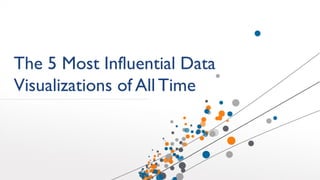The 5 most_influential_data_visualizations_of_all_time
- 1. The 5 Most Influential Data Visualizations of All Time
- 2. About these visualizations Data visualization allows us all to see and understand our data more deeply. That understanding breeds good decisions. Without data visualization and data analysis, we are all more prone to misunderstandings and missed opportunities. The following slides will show you 5 powerful, beautiful visualizations that changed how people thought about the world.
- 3. 5. London Cholera Map ŌĆō John Snow 1854. London. Cholera strikes. In just 10 days, over 500 people have been killed in one neighborhood. The mysterious cluster of deaths is especially terrifying because no one understands the source. No one besides John Snow, an epidemiologist who realized the water supply was spreading the disease.
- 4. 5. London Cholera Map ŌĆō John Snow He plotted every death on a map with ingenious mapped bar charts (see left) and was able to show that the closer to the Broad Street water pump he plotted, the greater the number of deaths. The information helped convince the public a true sewage system was needed and spurred the city to action.
- 5. 4. Gapminder ŌĆō Rosling The Swedish scientist Hans Rosling had been working with developmental data for over 30 years ŌĆō but it took a great visualization and a 2007TED talk for him to share his passion with the world. His original viz (now one of many) shows the relationship between income and life expectancy. The data is simple but RoslingŌĆÖs visual storytelling has allowed him to spread his passion for this fascinating, overlooked data to millions.
- 6. 3. March on Moscow ŌĆō Charles Minard
- 7. 3. March on Moscow ŌĆō Charles Minard In 1812, Napoleon marched to Moscow in order to conquer the city. 98% of his soldiers died. Fifty years later, while his country yearned for their former Imperial glory, the Parisian engineer Charles Minard chose to remind his country of the horrors of war with data.The simple but fascinating temperature line below the viz shows how cold ultimately defeated NapoleonŌĆÖs army. This viz still inspires those who see it to ponder the true cost of war.
- 8. 2.War Mortality ŌĆō Florence Nightingale
- 9. 2.War Mortality ŌĆō Florence Nightingale 1855.The Crimea. Britain is fighting a battle with both Russia and disease. As a nurse, how do you convince an army to invest in hospitals and healthcare instead of guns and ammunition? Florence Nightingale told her story with data by showing the staggering amount of deaths due to preventable disease (shown in blue/grey). After this viz, sanitation became a major priority for the British Army.
- 10. 1. Chart of Biography ŌĆō Joseph Priestley
- 11. 1. Chart of Biography ŌĆō Joseph Priestley The 18th century English educator and polymath Joseph Priestley had an ambitious goal: to teach his students the relationship between the nations of the past and the people that defined them. His creation ended up becoming two separate but related views. Here is a small snippet from the first which shows over 2000 historical figures.
- 12. 1. Chart of Biography ŌĆō Joseph Priestley The entire viz is enormous ŌĆō much too large for this format. However, what makes this viz especially amazing is that we can still learn from it at the aggregate level when we combine it with the second part of his two part visualization.
- 13. 1. Chart of Biography ŌĆō Joseph Priestley Using the same X-axis as the biography chart, this visualization shows the history of the major civilizations of the world over the same time period.
- 14. 1. Chart of Biography ŌĆō Joseph Priestley Together, they weave an intricate story.They explain and document both the rise and fall of empires, and the unique thinkers that defined those nations. Notice, as an example, the clusters of biographies and how they correlate to the major moments in human history ŌĆō the Greeks, the Romans, the Enlightenment, etc.
- 15. ŌĆ£The greatest value of a picture is when it forces us to notice what we never expected to see.ŌĆØ - JohnTukey, 1977
- 16. Want to Learn More? Watch a presentation about these visualizations: http://www.tableausoftware.com/tcc12conf/videos/5-influential-visualizations Read more about these visualizations: http://www.tableausoftware.com/about/blog/2012/11/top-5-visualizations-all-time-19810 Learn more about data visualization: http://tableausoftware.com Special thanks to Andy Cotgreave for creating the original compilation of visualizations.
- 17. Learn more about data visualization at http://tableausoftware.com

















